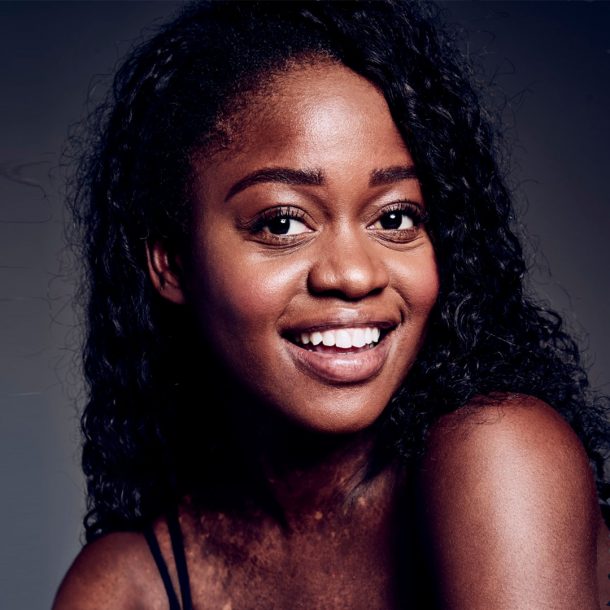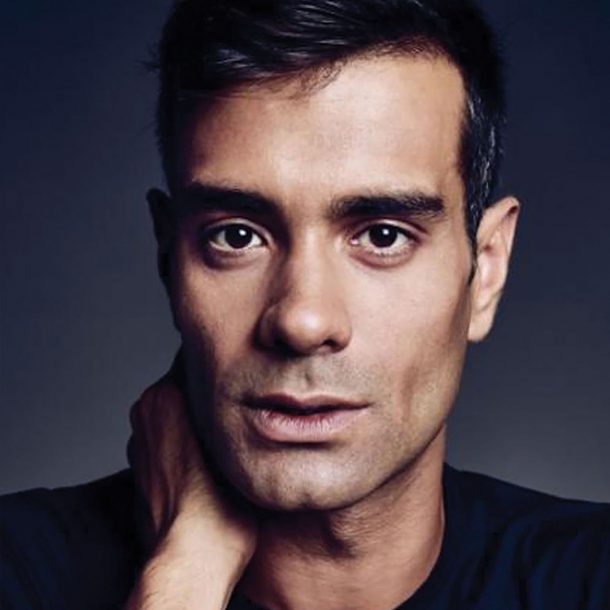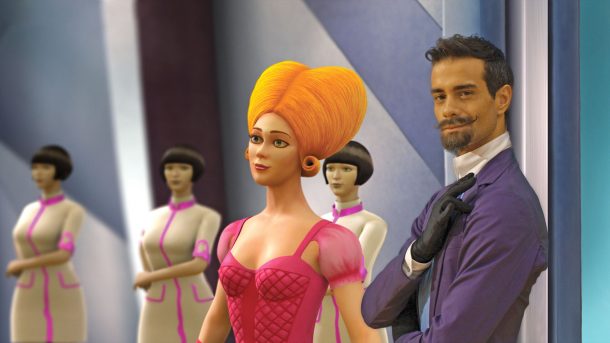Based stories by E.T.A Hoffman, Coppelia made its premiere as a comic ballet in the 1870’s. Despite this, Coppelia remains just as applicable to today’s audiences as it was when it was first written, covering themes and issues that transcend the barrier of time. Read interviews with the cast and creative team about what drew them to Coppelia, and how this adaptation seeks to show this classic story through a new, modern lens. Learn more about Great Performances: Coppelia.

Michaela DePrince. Photo credit: Urban Distribution Intl.
Michaela DePrince – Swan
What do you hope audiences will get from Coppelia?
I hope audiences of all ages will be inspired. We all struggle to find ways to fit the norm, or what people say the norm is, when being different and unique is much more special than trying to be what others want you to be.
How is this production of Coppelia subverting some of the stereotypes about ballet and making it more accessible for modern audiences?
This version of Coppelia is very modern, which I hope audiences will find relatable.
What are some of the key themes of the story you’re hoping to bring across?
Standing up for what you believe in. Protecting others from feeling that they aren’t good enough, and of course love and acceptance.
What do you love most about dance as a medium for storytelling?
It is the best way for me to express myself. Especially with this production, you understand what the story is about by just one small look and I think that’s beautiful.
How was it working with the production team to make this film?
It was a great experience. I was challenged in ways I’ve never been challenged before, but in a really positive way. I grew quite a lot in the process of making this film due to all the support I had from the production team.

Swan and Franz enjoying milkshakes in “Great Performances: Coppelia.” Photo credit: Urban Distribution Intl.
Daniel Camargo – Franz
What do you hope audiences will get from Coppelia?
I hope they will have fun watching it! I think the great thing about Coppelia the movie, is that it’s universal – there’s no dialogue, and the story is easy to understand. So audiences of all ages, from all over the world, will be able to watch and enjoy the film.
How is this production of Coppelia subverting some of the stereotypes about ballet and making it more accessible for modern audiences?
It’s a very updated and relevant version of Coppelia, so it will allow audiences to see and understand the story through a new lens. What are the stereotypes about ballet? If you’ve never seen ballet before, I’m sure you’ll enjoy this. It’s great fun, and the dance is really used to drive the story along. It’s just like a musical, but with dance instead of songs! It’s a very easy style. You don’t have to know anything about ballet to enjoy the film.
What are some of the key themes of the story you’re hoping to bring across?
Anyone can enjoy and express themselves through dance, without any restrictions, be it color, sexual orientation or background. That’s not a part of the story, but this naturally comes across through the film! The key theme is ‘Be yourself’. Be confident and happy being who you are, you don’t have to change yourself to suit someone else’s idea of what is beautiful. Oh, and it’s also a nice love story! Which everyone enjoys.
Why do you think the story of Coppelia is still relevant today?
This telling of Coppelia brings a number of contemporary issues to the forefront. Young people today are facing a lot of pressure, especially on social media, to look a certain way. More and more young people want to have cosmetic surgery. It’s important we remind young people, it’s OK to be yourself, you shouldn’t feel any pressure.

Vito Mazzeo. Photo credit: Urban Distribution Intl.
Vito Mazzeo – Coppelius
What do you hope audiences will get from Coppelia?
My first hope is that the audience will understand that Ballet is an art form not just related to theatre. The magic of live performance is one of the things that made me decide to start this career, but Ballet in Cinema can work beautifully, as this movie will show.
What are some of the key themes of the story you’re hoping to bring across?
My character Doctor Coppelius is a cosmetic surgeon, and the film explores that “beauty” is not enough without depth. In Italy we say “not everything that sparkles is gold”, which I think is particularly relevant today. Everybody works very hard to cultivate the best external image, but what’s inside should be fed in an equal way.
What do you love most about dance as a medium for storytelling?
Once a friend of mine took me to Palazzo Sacchetti in Rome where Francesco Salviati painted a fresco showing David dancing in front of Ark of the Covenant and he told me “you see David, when he has in front of him the presence of God, the first thing he does is to dance”. He made me recognize that I do one of the most wonderful jobs in the world, that has such a powerful potential for communication – and it’s a language that we make use of in this film.
How was it working with the production team to make this film?
When we started this film, I had just suffered the loss of my best friend. I started the first day crying and by the last I was smiling of joy. The care of the directors, producers and everyone involved was like fresh air to me. The experience of learning new things every day, feeling the love of every single person involved, working next to Darcey and Irek, doing research at night for the character, watching the work of Eduardo de Filippo and Alberto Sordi and the amazing times spent together like a family will stay with me forever.

Coppelia and Doctor Coppelius in “Great Performances: Coppelia.” Photo credit: Urban Distribution Intl.
Jeff Tudor, Steven de Buel, Ben Tesseur – Directors
What do you hope audiences will get from Coppelia?
ALL: We hope the audiences:
- will be drawn into the fantasy world and the unique way of story-telling;
- enjoy a cinematic experience that goes beyond their expectations!
- leave the cinema feeling positive – humming the music and dancing
- pick up a little of the underlying message: superficial beauty is not everything – true beauty comes from within – and diversity is something to be celebrated. We also hope the film goes beyond the ‘dance’ audience and reaches a mainstream, family audience.
Jeff Tudor: When I was a child, I loved films that mixed live action and animation. I found it magical, watching Gene Kelly dance with an animated character (Invitation to the Dance and Anchors Aweigh); Mary Poppins, stepping into an illustrated world that came to life; the children’s adventures in Bedknobs and Broomsticks. It has always been stimulating for children when live action characters explore animated worlds, and I hope we have recreated that magic for today’s audience.
What are some of the key themes of the story you’re hoping to bring across?
ALL: Learn to be happy with who you are – and don’t try to be something you’re not because of someone else’s ideals. Who’s to say what’s beautiful? True beauty comes from within, and it’s dangerous to be too concerned with outward appearances. Coppelia is the story (gently told) of the commercialisation of beauty and the negative effect of the images we are all force-fed – dangerous, hyper-real, superficial, Photoshopped interpretations of ‘beauty’. Another important message of the story is that love conquers all!
Why did you choose this particular ballet as an inspiration for a multi-media feature?
ALL: What inspired us was an interesting storyline, a message that is very relevant to today’s audience, and a strong female lead. The theme also provided us with an ideal starting point for mixing live action and animated characters. The choreography was specially made for the film, created with the animated elements in mind. We use a different visual language / medium compared to a theatre performance. The choreography was created in collaboration with Ted Brandsen (choreographer), the dancers of Dutch National Ballet and other cast members.
Does the animated element give you access to anything you wouldn’t get with live-action set design?
ALL: Our story is told without words, so we were looking for a strong visual setting. We had more freedom to develop this by using CG sets mixed with live action props and elements. On one hand we have the organic world of Swan and her friends. Even though Swan’s environment is recognisable, it’s a world filled with music and dance, where people interact in a different way to how we act in real life. CG allowed us to create a world for Swan that is quirky, with an illustrated feel. On the other hand, we have the clinical, sinister world of Doctor Coppelius, and CG enabled us to create a huge scale clinic for the Doctor. While the CG sets gave us certain freedoms, they also brought a lot of restrictions too, of course!
How are you using the animation to tell more of the story?
ALL: The animation allows us to take the audience into a fantasy world. The 3D characters – Coppelia and the Doctor’s Assistants – represent what is fake and superficial. The animation of the townspeople, after they are treated by the Doctor, supports the allegorical idea that they sell their souls to Doctor Coppelius: when he performs his ‘treatment’ on them, he tricks them into believing they have been transformed. They think they see a new version of themselves reflected in the mirror, but actually it’s just a trick, like a Snapchat or Instagram filter. The ‘treatment’ the Doctor performs is just a ruse for him to extract the ‘essence’ from the townspeople’s characters, leaving them vain and self-obsessed. How did you go about casting the film? What was important for you to have in the performances as this is a non-verbal story? ALL: As directors, we had to be totally confident the actors could portray their characters with depth, intelligence and heart – without words. Everyone in this film is a serious, sensitive artist. Working in a green / blue screen environment, we relied heavily on the actors using their imaginations and responding to placeholder props and set elements which were only animated in later. So our cast members also had to have vivid imaginations! We wanted a diverse cast, to reflect the reality of today’s society. Luckily for us, the ballet company we collaborated with, Dutch National Ballet, is pretty diverse and very international. Michaela DePrince stood out for us. Her charisma, her strong personality and her athletic dance ability. And Daniel Camargo, a fantastic dancer who also has a wonderful ability to act naturally – and great chemistry with Michaela. Vito Mazzeo was a natural choice for our villain.
JT: I’ve seen Vito playing many villainous stage roles and knew he would bring something special to the role of the Doctor! We also wanted a cast that included international icons of the dance world, such as Darcey Bussell and Irek Mukhamedov.
How have you chosen to approach music in the film?
ALL: It was very important to us to have a film score rather than a ballet score. We wanted the viewer to have a familiar response to what they were hearing, the score should sound like a film – expressive, emotive, ambient. Compared to the original music for the 150-year old ballet Coppelia, our score is a much stronger story-telling element, supporting the action and emotions. We also use a broader range of music and instruments than in the original stage ballet, mixing electronic and classical sounds, and using these to develop specific themes for certain characters and emotions.
Can you describe the visual style of Coppelia, and the choices behind the animated set design?
ALL: We wanted to create something out of the ordinary, full of fantasy, but believable: we must believe that our characters can live, work, eat, drink and dance in this world. We have developed our own world, together with art director Erik Fokkens and production designer Vincent de Pater. There’s a clear visual difference between Swan’s world and the world of Doctor Coppelius. Swan’s town is colourful, sweet and quirky, and low-tech. For the Doctor’s clinic we use harder colours and textures, with Coppelia’s signature colour a very harsh pink. In order to create better integration between live action and CG, we use both real and animated props. A bicycle may be real in one shot and drawn in another. Some of our set design choices were actually governed by technical or practical requirements. For example, our cast needed enough space to dance!
